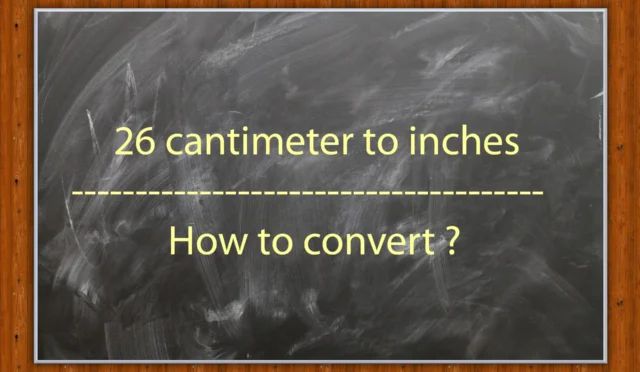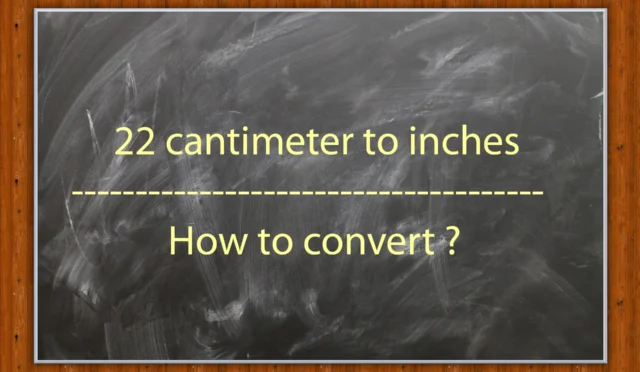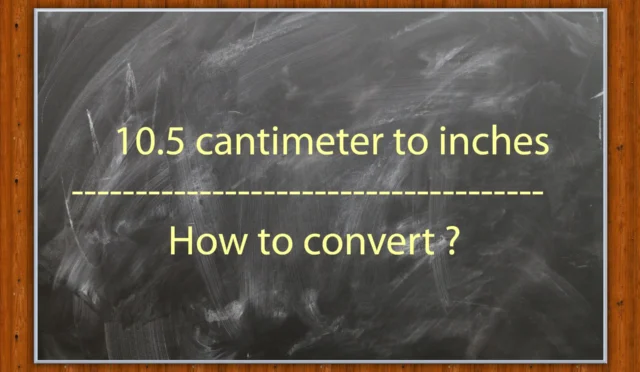23 cm to Inches: How to Convert and Why it Matters
If you’ve ever needed to convert between metric and imperial units of measurement, you may have found yourself needing to convert centimeters to inches. In this article, we’ll cover everything you need to know about converting 23 cm to inches, including why it matters, how to convert, and some common questions related to unit conversion.
23 cm is a common measurement used in many contexts, such as sewing, crafting, and science. If you’re accustomed to using the imperial system of measurement, you may find yourself needing to convert this measurement to inches. In this article, we’ll explore the basics of converting 23 cm to inches, and provide tips and resources for accurate conversions.
Understanding Centimeters and Inches
Centimeters and inches are both units of measurement used to express length or distance. Centimeters are part of the metric system of measurement, while inches are part of the imperial system. One centimeter is equal to 0.3937 inches, while one inch is equal to 2.54 centimeters.
Why Conversion is Necessary
Conversion between metric and imperial units is necessary in many situations. For example, if you’re traveling to a country that uses the metric system, you may need to convert measurements from imperial to metric. Additionally, certain industries, such as science and engineering, may use one system exclusively, so conversion between units is necessary for accurate calculations and measurements.
How to Convert 23 cm to Inches
To convert 23 cm to inches, simply multiply 23 by 0.3937, which is the conversion factor from centimeters to inches:
23 cm * 0.3937 in/cm = 9.0551 in

Therefore, 23 cm is equal to approximately inches.
Converting Between Inches and Centimeters
Converting between inches and centimeters is a straightforward process, as long as you remember the conversion factors. To convert inches to centimeters, multiply the length in inches by 2.54. To convert centimeters to inches, multiply the length in centimeters by 0.3937.
Common Conversion Factors
Here are some common conversion factors for length or distance:
- 1 inch = 2.54 cm
- 1 cm = 0.3937 in
- 1 foot = 12 inches
- 1 meter = 100 centimeters
- 1 yard = 36 inches
Tips for Accurate Conversions
When performing conversions between units of measurement, it’s important to use accurate conversion factors and methods. For example, the conversion factor from centimeters to inches is only an approximation, and using more decimal places can lead to more accurate conversions. Additionally, rounding errors can accumulate when performing multiple conversions, so it’s best to use the original value when possible.
Online Conversion Tools
There are many online tools available for converting between units of measurement, including centimeters and inches. These tools often allow you to select the units you are converting between, and may provide additional features such as unit-specific calculations and conversion charts.
Precision in Measurement
Precision is important in many industries, such as science and engineering, where even small errors in measurement can have significant consequences. Accurate conversion between units of measurement is necessary for precise calculations and measurements. In addition, being able to communicate measurements accurately and precisely is crucial for collaboration and reproducibility.
Frequently Asked Questions
Can I convert inches to feet and inches?
Yes, you can convert inches to feet and inches by dividing the length in inches by 12 to get the number of feet, and using the remainder as the number of remaining inches. For example, to convert 36 inches to feet and inches:
36 in / 12 in/ft = 3 ft
Therefore, 36 inches is equal to 3 feet and 0 inches.
How do I convert meters to centimeters?
To convert meters to centimeters, multiply the length in meters by 100. For example, to convert 2.5 meters to centimeters:
2.5 m * 100 cm/m = 250 cm
Therefore, 2.5 meters is equal to 250 centimeters.
Why are there different systems of measurement?
Different systems of measurement have developed over time in different regions of the world, based on factors such as historical influence, practicality, and cultural preferences. The metric system was developed in France in the 18th century, and is now used widely around the world. The imperial system, on the other hand, has its roots in ancient Rome and was adopted by the British Empire, and later the United States.
How accurate are conversion factors?
Conversion factors are generally accurate to a certain degree of precision, but they may not be exact. For example, 0.3937 inches per centimeter is an approximation, and using more decimal places can lead to more accurate conversions. It’s important to keep in mind the precision of the conversion factor when performing calculations.
Can I use online conversion tools for precise measurements?
Online conversion tools can be useful for quick estimations or general conversions, but they may not provide the level of precision required for certain applications. It’s best to use more precise conversion factors and methods for accurate measurements.
Conclusion
Converting between centimeters and inches is a common task, and is necessary in many contexts, from crafting to science. By understanding the principles behind unit conversion, and using accurate conversion factors and methods, you can ensure precise and accurate measurements. With the help of online conversion tools and a basic understanding of the conversion factors involved, you can easily convert 23 cm to inches, or any other units of measurement you may encounter.
And by understanding the importance of precision in measurement, you can ensure that your calculations and measurements are accurate and reliable. Whether you’re traveling, working in a technical field, or simply need to make measurements in different units, understanding how to convert between units of measurement is a crucial skill to have.
In summary, 23 cm is equal to approximately 9.0551 inches, and conversions between these two units of measurement can be performed using conversion factors. By following the conversion methods outlined in this article, and being mindful of precision, you can ensure accurate conversions between units of measurement. And with the help of online conversion tools, you can make these conversions quickly and easily. So next time you find yourself needing to convert 23 cm to inches, you’ll know exactly how to do it!
FAQs
- Can I convert inches to millimeters?
Yes, you can convert inches to millimeters by multiplying the length in inches by 25.4. For example, to convert 3 inches to millimeters:
3 in * 25.4 mm/in = 76.2 mm
Therefore, 3 inches is equal to approximately 76.2 millimeters.
- How do I convert feet to meters?
To convert feet to meters, multiply the length in feet by 0.3048. For example, to convert 6 feet to meters:
6 ft * 0.3048 m/ft = 1.8288 m
Therefore, 6 feet is equal to approximately 1.8288 meters.
- Can I convert centimeters to yards?
Yes, you can convert centimeters to yards by dividing the length in centimeters by 91.44. For example, to convert 500 centimeters to yards:
500 cm / 91.44 cm/yd = 5.468 yd
Therefore, 500 centimeters is equal to approximately 5.468 yards.
- How do I convert fractions of an inch to millimeters?
To convert fractions of an inch to millimeters, first convert the fraction to a decimal, and then use the conversion factor from inches to millimeters. For example, to convert 5 1/2 inches to millimeters:
5.5 in * 25.4 mm/in = 139.7 mm
Therefore, 5 1/2 inches is equal to approximately 139.7 millimeters.
- Why is it important to use accurate conversion factors?
Using accurate conversion factors is important for ensuring precision in measurements and calculations. Small errors in measurement can have significant consequences in certain industries, so it’s important to use the most accurate conversion factors possible. Additionally, being able to communicate measurements accurately and precisely is crucial for collaboration and reproducibility.






